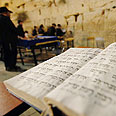
Making the Bible more accessible
Photo: Eli Elias

'Kids hardly read'
Photo: Ablestock
The Education Ministry has recently introduced a new comic book into school curriculums in order to facilitate Bible studies among elementary school students.
The book, which contains an illustrated version of the books Samuel and Judges (Shoftim), is intended for use among fifth and sixth grade students, but the ministry plans to gradually expand the use of comics to all elementary school grades.
Comic Free
Kobi Nahshoni
Fifteen-year-old Sapir Malka dedicates victory to classmates slain in 2008 attack on Jerusalem's Mercaz Harav Yeshiva; asks Netanyahu to assist in efforts to get US-held Israeli spy out of jail
It should be stressed that the books are meant to accompany and compliment the students' reading of the original biblical text, rather than replace it.
This is yet another move in a series of initiatives taken by the national supervisor of Bible studies at the Education Ministry, Drora Halevi, whose purpose is to bring children closer to the subject matter.
Other initiatives included trips to known biblical sites, the incorporation of artworks by famous painters such as Michelangelo, Rembrandt and Chagall in Torah studies, and an online study program.
Speaking to kids in their language
Halevi explained that love of the Bible stems from an understanding of the text, sympathizing with the characters, a sense of familiarity with the places where the stories took place, and dealing with ethical dilemmas.She said that the comic book, which was written by Noya Sagiv and illustrated by Bella Goldenberg, enables teachers to "obtain quality teaching objectives through a humoristic experience.
"The comics allows students to understand the text, particularly at a time when students read very little, and read the Bible even less, and are having trouble understanding it," she added.
Studying through cartoons, Halevi believes, "Connects the students to the Bible via their own world, and we have to adjust the teaching to the reality of the 21st century. We have to teach students in their way and help them feel close to the events."















